The History of Durham Castle
Durham Castle is the story of 1,000 years of British history.
From the Norman Conquest to the Tudor Reformation, the English Civil Wars to the restoration of the monarchy, and from the establishment of a university to two world wars; Durham Castle has been at the heart of local and national history.
Scroll down or use the menu to follow the journey from the castle’s turbulent early beginnings, right up to the present day.

Before the Castle

We know that even before the Norman Conquest, Durham was a bustling town. Just outside the site of the Castle’s moat, we have evidence of Anglo-Saxon building, shoemaking, and leatherworking, proving there was a thriving community, possibly with a fortress at the core. This fortress likely stood where Durham Castle is today, and there are the remains of a pre-Norman wall inside the Castle.
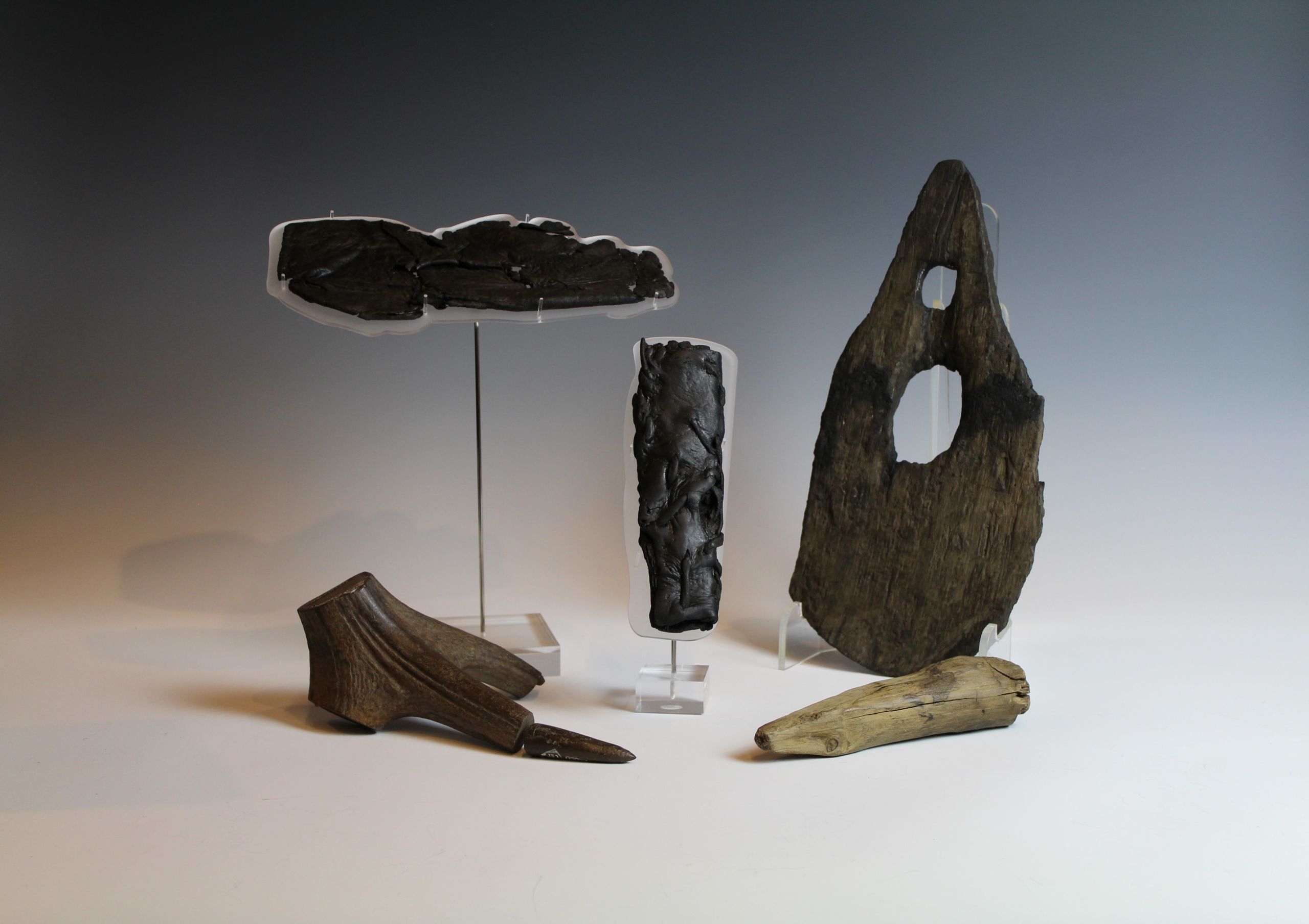
Pre-Norman archaeology found on Saddler Street, Durham
The importance of the Durham peninsula was strengthened by the arrival of the Lindisfarne monks in 995 AD. The monks sought a place of refuge and chose Durham as the perfect site to lay the remains of Saint Cuthbert and build a community.
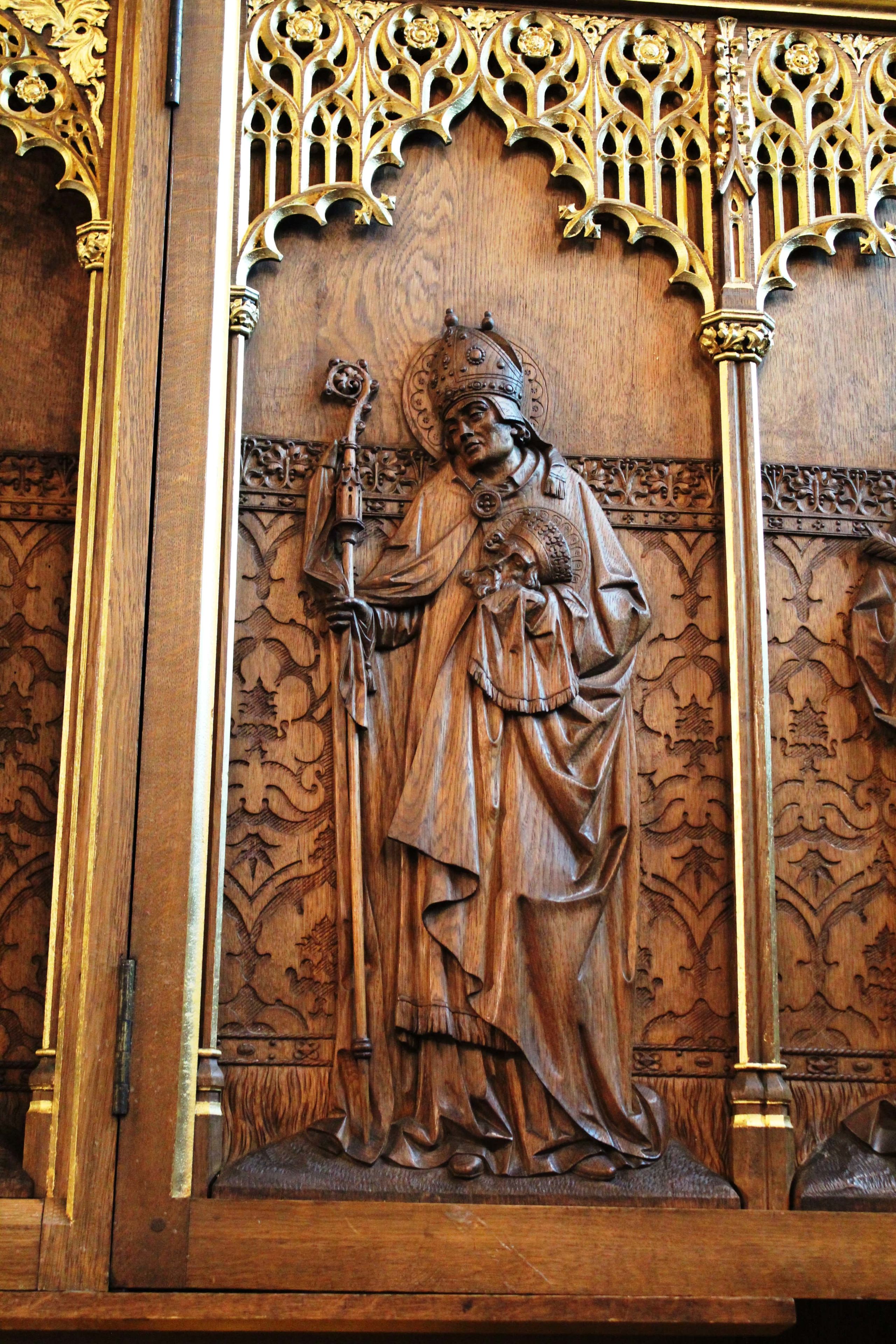
St. Cuthbert altar at Durham Castle
It may have also been the defensive nature of the Durham Peninsula, which appealed to the monks. We have historical evidence that the defences were tested. In both 1006 and 1039, Durham was able to repel two attacks from Scottish armies. After the defeat in 1006 of King Malcolm of Scotland and his troops, the heads of Scottish soldiers were displayed around the city, after Durham women had washed their faces and combed their hair.
These would not be the last attempts to invade Durham.

Pre-Norman archaeology found on Saddler Street, Durham
Pre-Norman archaeology found on Saddler Street, Durham

St. Cuthbert altar at Durham Castle
St. Cuthbert altar at Durham Castle
The Norman Conquest

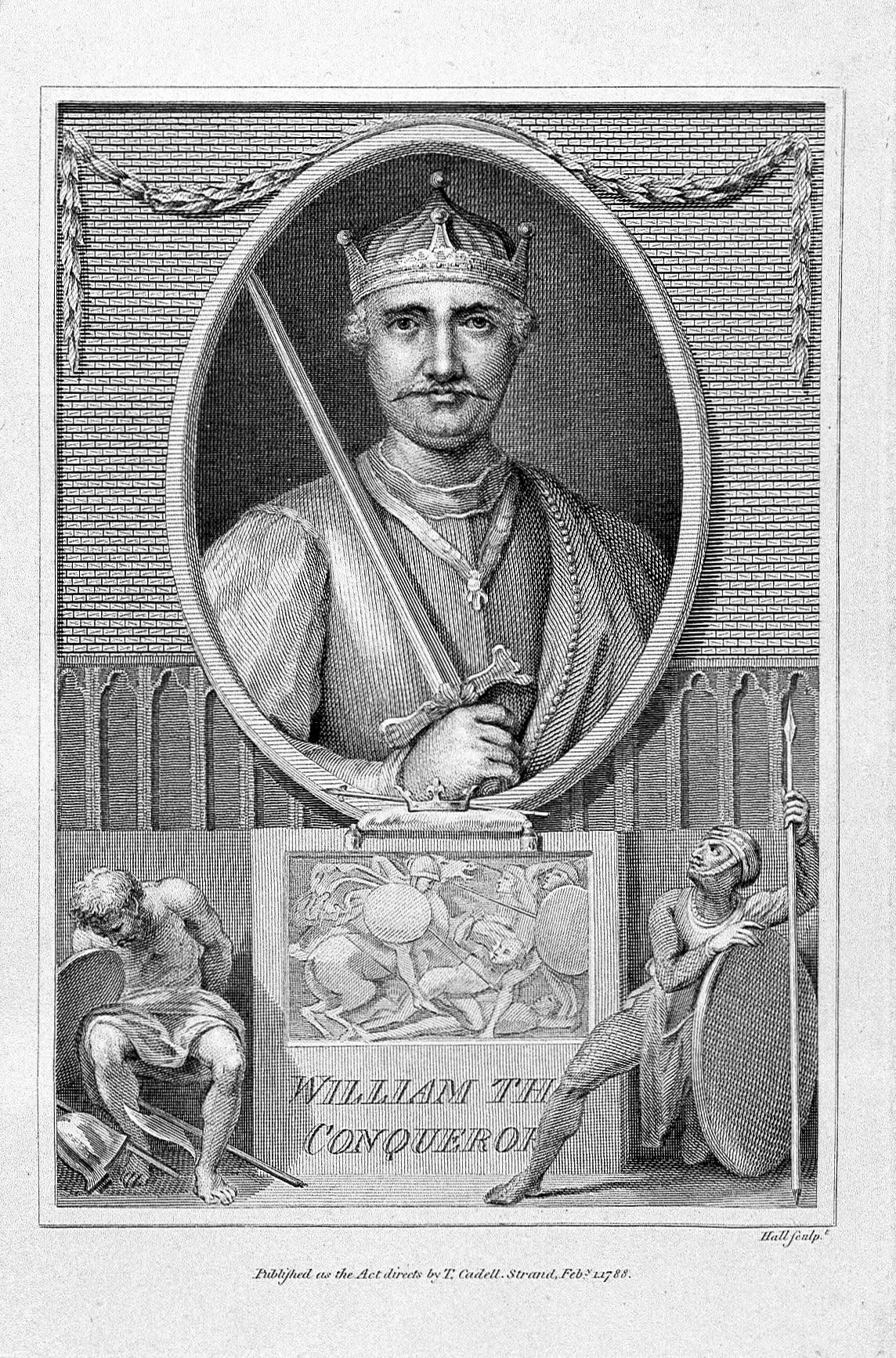
William the Conqueror, courtesy of Wellcome Collection
William the Conqueror, courtesy of Wellcome Collection
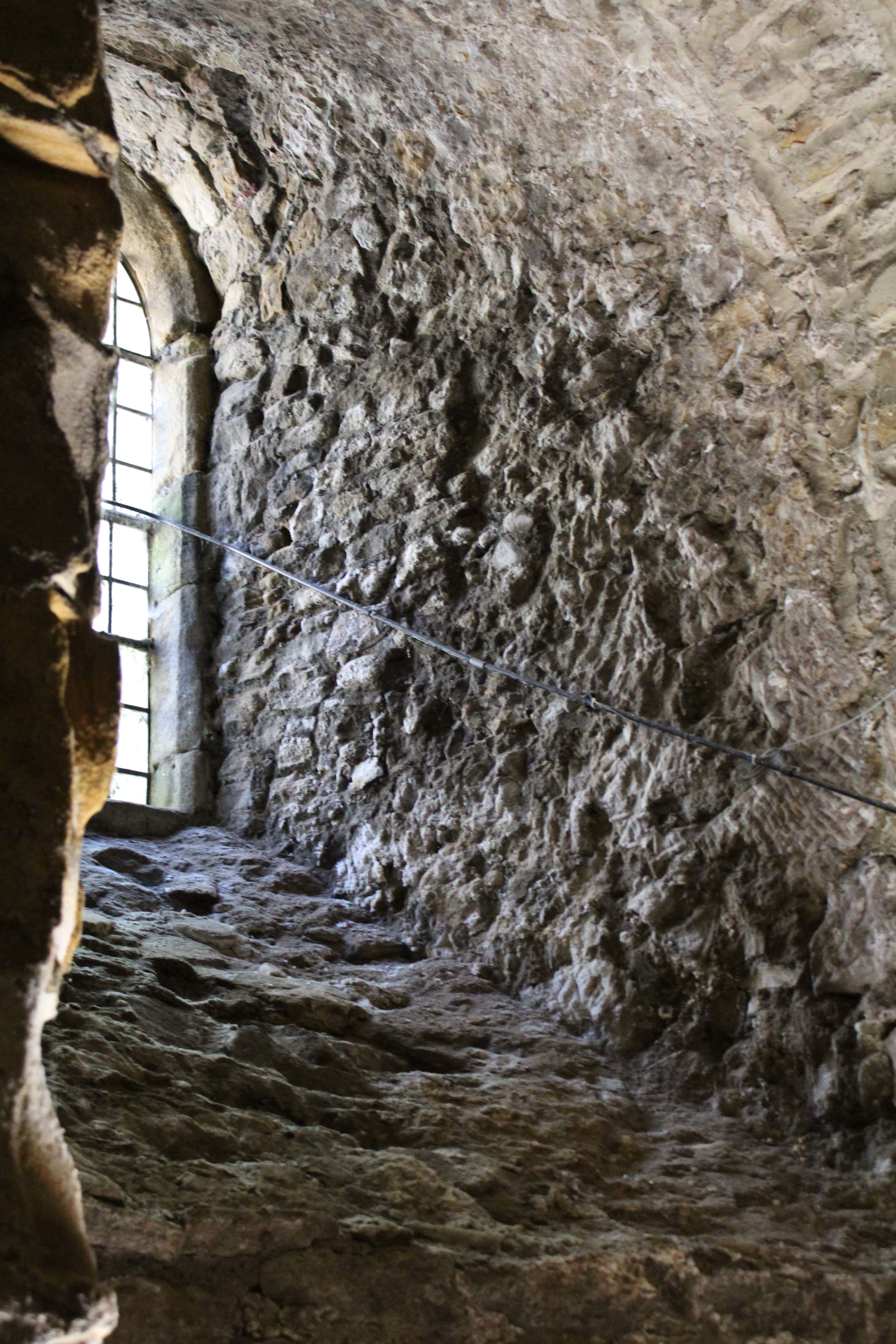
Curtain wall in the Norman Chapel
Curtain wall in the Norman Chapel
William the Conqueror became the first Norman King of England following victory at the Battle of Hastings in 1066, but this shift in power was not immediately accepted in the north.

William the Conqueror, courtesy of Wellcome Collection
The Earl of Northumbria controlled the North, and after two Earls were murdered and the third rebelled, William appointed a Norman, Robert de Comine, who, along with 700 men in 1069, were ambushed and murdered in Durham. The response from the new King was a devastating campaign to repress northern resistance.
Known as the Harrying of the North, William’s campaign lasted 2 years. Villages and food stores were destroyed, livestock slaughtered, and crops laid to waste. It is estimated that 100,000 people were killed or died of famine during the campaign.
The order for the construction of Durham Castle was given in 1072. The new castle would protect the Norman rulers from the rebellious local population and potential invasions from Scotland.
Opposition to the Norman rule was a real threat, and even whilst the castle was being constructed, rebellion was close at hand. Waltheof, the Earl of Northumbria who was tasked with building Durham Castle, rebelled and was later executed.

Curtain wall in the Norman Chapel
The Prince Bishops
The need to establish and maintain order in the North was crucial. William granted additional powers to the Bishop of Durham, giving them greater authority in return for their loyalty. This was an interesting political tactic that took power away from the local ruling elite and gave it to a representative of the king. They ruled what was effectively a state within a state.
Holding the title of Prince Bishop, these powerful leaders could levy taxes, mint their own coins, have their own courts, raise an army and had responsibility for protecting the northern frontier.
These were not just men of the church; they were powerful politicians and rulers who were often embroiled with the politics, threats, rebellions and scandals of the day.

Bishop Saint Calais, pictured in a manuscript from Durham Cathedral Library. MS A.II.4 (1)
Bishop Saint Calais, pictured in a manuscript from Durham Cathedral Library. MS A.II.4 (1)
Bishop Saint Calais, the second Prince Bishop, who is thought to have built the Norman Chapel, rebelled against the King, William Rufus, in 1088, and took refuge in the newly built castle when the King sent troops to capture him.
Bishop Flambard, who built the North Range of Durham Castle and cleared the market from Palace Green, was known for his sharp wit and forceful personality, and had an equally colourful career. He was the first person imprisoned in the Tower of London and became the first person to escape the Tower in 1101, when he smuggled a rope into the Tower and escaped after getting his guards drunk.

Medieval Durham
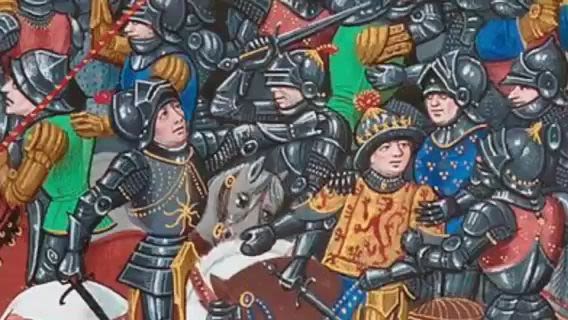
As Norman rule became more established, the 13th and 14th centuries were relatively calm, allowing the Prince Bishops to enhance their wealth, status and power.
The substantial income of the Bishops saw the beginnings of the castle’s evolution into a palatial residence, frequently remodelled to reflect changes in taste and fashion.

Bishop Bek built the castle’s Great Hall in the early 14th century, most likely to coincide with a visit of King Edward I. Keen to use the space to entertain and impress, it was said that Bishop Bek had a throne at either end of the Great Hall.
Bishop Bek built the castle’s Great Hall in the early 14th century, most likely to coincide with a visit of King Edward I. Keen to use the space to entertain and impress, it was said that Bishop Bek had a throne at either end of the Great Hall.

Bishop Bek held the position from 1284-1310. This coin was minted during his reign
Bishop Bek held the position from 1284-1310. This coin was minted during his reign
The Bishops had castles, manor houses and hunting lodges throughout the north, including Auckland Castle, Stockton Castle, Westgate Castle, Norham Castle, Bishop Middleham Castle and a Manor House in Darlington.
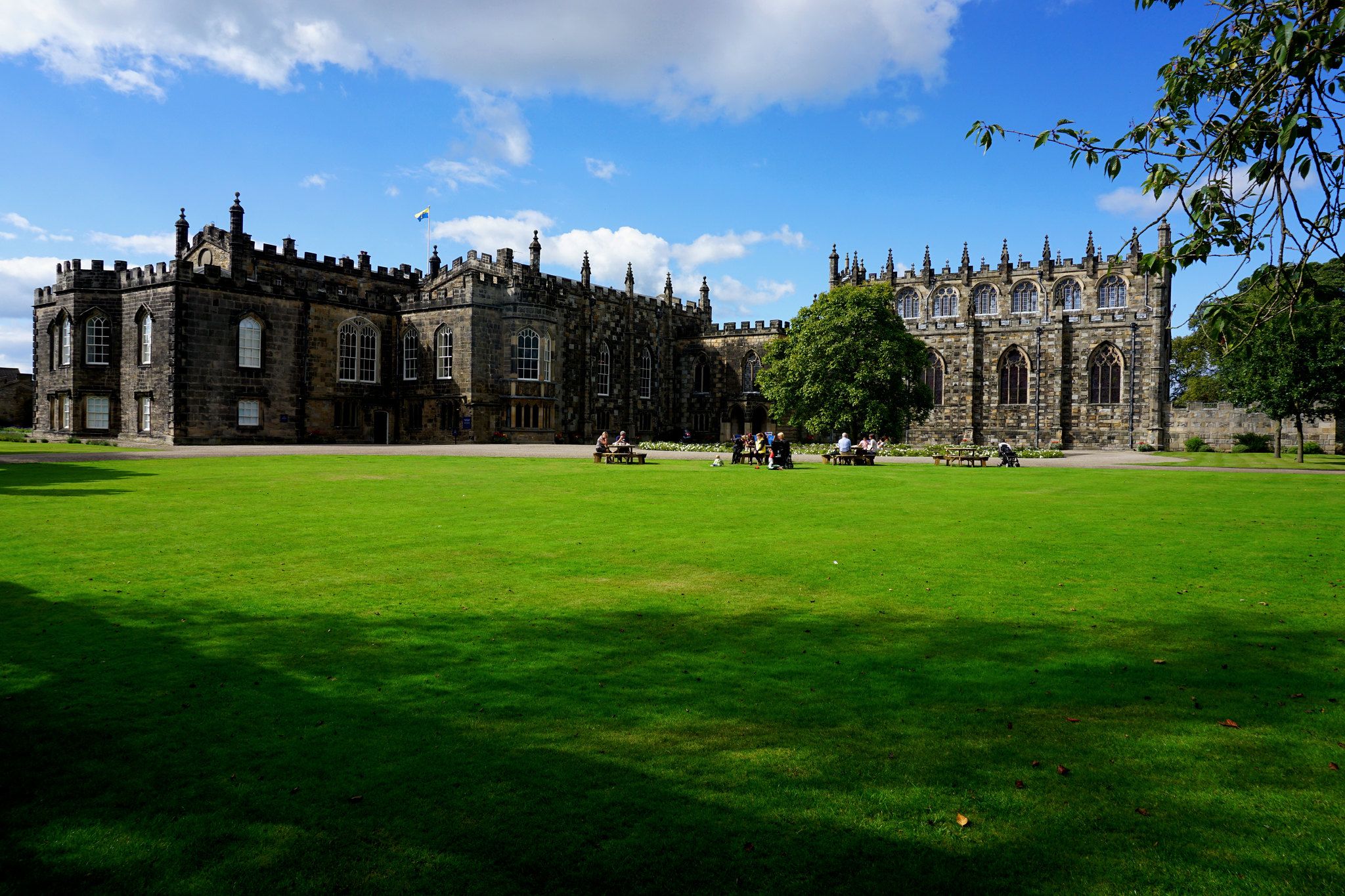
Auckland Castle, courtesy of Barnyz, Flickr
"There are two kings in England, namely the Lord King of England, wearing a crown in sign of his regality and the Lord Bishop of Durham, wearing a mitre in place of a crown, in sign of his regality in the diocese of Durham."
Steward of the Bishopric William de St Botolph, 1302
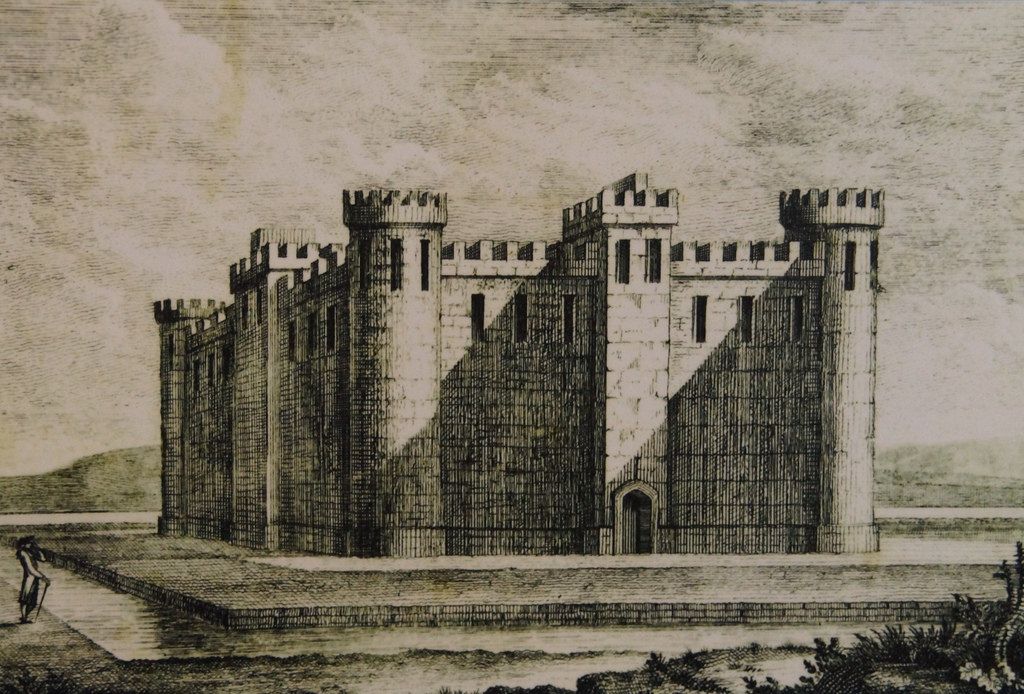
Stockton Castle
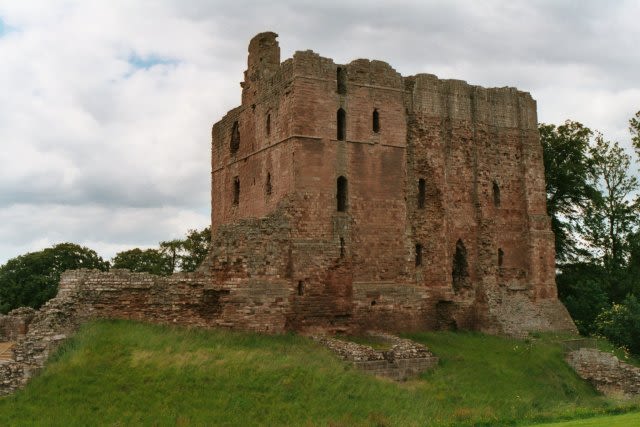
Norham Castle, © Martin Norman
During the Medieval period, many kings and queens visited Durham Castle including Edward I, Philippa of Hainault Queen to King Edward III, Henry III, King John, Edward III and Henry VI.

Auckland Castle, courtesy of Barnyz, Flickr
Auckland Castle, courtesy of Barnyz, Flickr

Stockton Castle
Stockton Castle

Norham Castle, © Martin Norman
Norham Castle, © Martin Norman
Medieval Pursuits
Hunting
Westgate Castle, built by Bishop Bek, was not only a hunting lodge but was also used for Forest Courts, for collecting rent and on occasion, as a prison. It was also the location of the Medieval Great Chase, which was an elaborate expedition to Upper Weardale to hunt deer, wild boar and wolves.
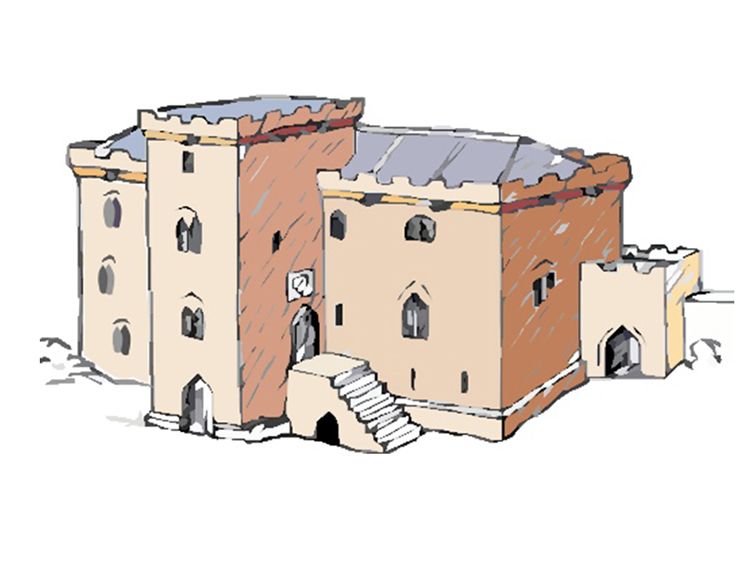
Sketch of Westgate Castle, by Peter Ryder
Hunting was an important privilege, and in 1109, Henry I gave the Bishopric of Durham a Royal Charter granting ownership and hunting rights for all the forests between the rivers Tyne and Tees. The Great Chase demonstrated the Bishop's power and status.
War
The need to defend the north was still an important part of the Bishop’s role, and both Bishop Bek and Bishop Thomas Hatfield were described as warrior bishops, for their role in fighting Scottish armies. Bek commanded one wing of the army, which defeated William Wallace at Falkirk in 1298, and Hatfield helped to defeat David II of Scotland at the Battle at Neville’s Cross in 1346.
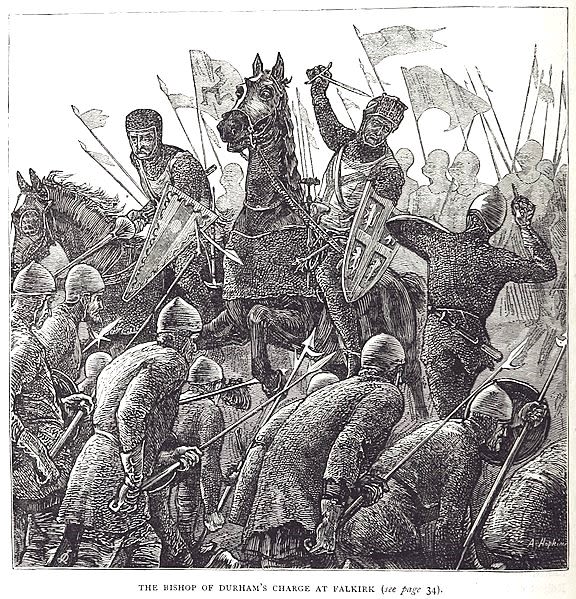
Bishop Bek at the Battle of Falkirk
Medieval food
In 1991, an archaeological investigation on the site of the dry moat revealed a little about the sort of food that was being eaten at Durham Castle, between the 14-16th century.
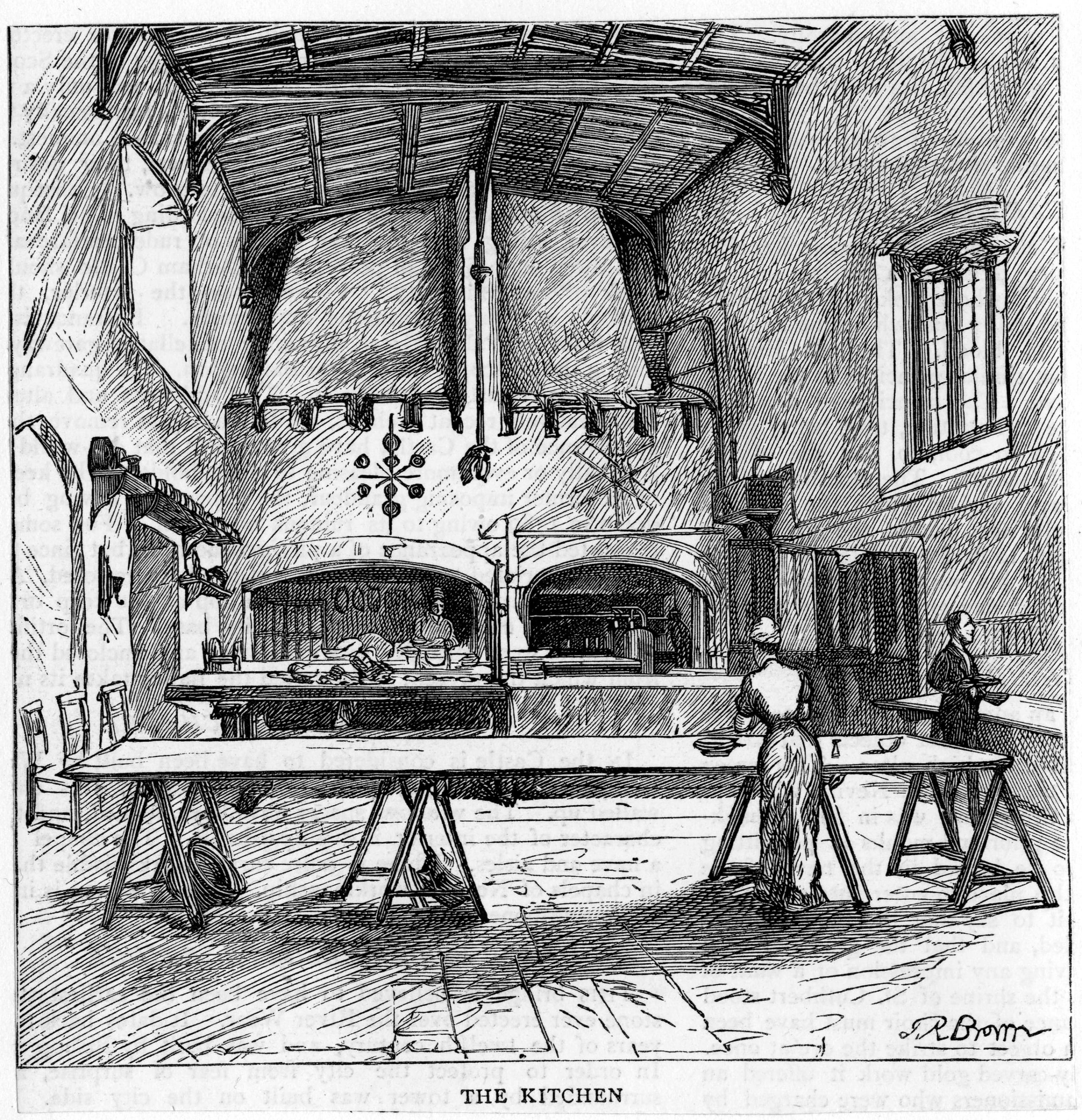
19th century sketch of the kitchen at Durham Castle
Over 9,000 fragments of bone were recovered, revealing that the residents of Durham Castle were eating prime beef and pig, and younger pigs, possibly as suckling pigs. While they were consuming high-quality bread, archaeologists didn’t find evidence of eating exotic species such as wild boar, swan or peacock.

Sketch of Westgate Castle, by Peter Ryder
Sketch of Westgate Castle, by Peter Ryder

Bishop Bek at the Battle of Falkirk
Bishop Bek at the Battle of Falkirk

19th century sketch of the kitchen at Durham Castle
19th century sketch of the kitchen at Durham Castle
The Tudors

With the beginning of the Tudor period, the Bishop’s power began to decline, but they were still important political players.
Bishop Fox, who transformed the Great Hall and refurbished the kitchen, helped prevent James IV of Scotland’s attempt to usurp King Henry VII in 1496. He later brokered the marriage alliance that saw James marry Henry’s daughter, Princess Margaret Tudor. Margaret stayed at Durham Castle in 1503, as she travelled north for her wedding, and a great double banquet was held.

Bishop Richard Fox held the position of Prince Bishop of Durham from 1494-1501. This portrait is from an oil on panel painting by Johannes Corvus, c. 1522. Courtesy of Corpus Christi College, Oxford
Bishop Richard Fox held the position of Prince Bishop of Durham from 1494-1501. This portrait is from an oil on panel painting by Johannes Corvus, c. 1522. Courtesy of Corpus Christi College, Oxford

The motto of Bishop Fox, a pelican piercing its breast, can be found in the kitchen of Durham Castle
The motto of Bishop Fox, a pelican piercing its breast, can be found in the kitchen of Durham Castle
One of the Castle’s most remarkable Bishops was Cuthbert Tunstall, who was regarded as one of the great minds of his age and praised by Erasmus for his intelligence and lively humour.
Tunstall made significant changes to Durham Castle. He raised the entrance of the Gatehouse to allow carriages in, and he constructed a new range, with a chapel and grand Tudor Gallery. These impressive new spaces further enhanced the castle as a place for recreation and entertaining, making the gallery an ideal place for people to meet and discuss the big ideas of the age, and reflect his prominent position as a public figure.
Tunstall was an extraordinary man: bishop, diplomat, politician and scholar. He was one of the most influential men of his time, and his additions meant that Durham Castle’s move to a palace was complete.
Find out more about Tunstall in our online exhibition, Tunstall and The Tudors: The Calculating Bishop.

The Reformation
The reign of King Henry VIII, and particularly his break from the Catholic Church, had a significant impact in Durham.
Known as the Reformation, the period saw Henry becoming head of the new Protestant Church of England, created, in part, to allow the King to divorce his first wife, Catherine of Aragon. The old religious institutions were stripped of wealth and power, with Durham Cathedral’s gold, silver and jewels a prime target, although Tunstall did manage to protect the Cathedral library.
Tunstall remained a Catholic. He regularly disagreed with Henry, who even sent men to find incriminating evidence on Tunstall. It is rumoured that Tunstall was tipped off by Thomas More, and no evidence against Tunstall was found.
In 1538, Bishop Tunstall was forced to hand back several of his unique powers and privileges to the crown. The Bishop of Durham was no longer able to mint coins, raise an army or pass judgement in cases of treason. This period of change saw local rebellions in Durham, and Tunstall struggling to balance his Catholic faith with the new religious powers of the monarchy.
Tunstall was arrested and imprisoned in the Tower of London by Edward VI for his resistance to religious reform, and the Bishopric was removed from him. However, under the Catholic Mary I, all his powers were fully restored.
Following Elizabeth I’s ascension to the throne, he refused to take the Oath of Supremacy, as she was a protestant.
He was deprived of his position once again, and put under house arrest at Lambeth Palace, where he died at the age of 85.
Click the icons to learn more about Bishop Tunstall
The Stuarts and the English Civil Wars

With the end of the Tudors and the dawn of the Stuarts, Durham wanted to impress the new monarchs.
James I was hosted for a celebration at Durham Castle in 1617, marking the removal of the threat of Scottish invasion for Durham, and the hope of a greater economic development. However, the visit did not end well for the then Bishop James, who was scolded by the King.
It is said that after this, the Bishop retired to Auckland Palace and died 3 days later. The aim to impress the Stuarts continued, and Charles I visited the castle on the way to his Scottish coronation in 1633, then again in 1639. The castle was still a significant venue for entertaining royalty.
The 1640s saw a period of turmoil and political upheaval around the country.
Even before the English Civil Wars, Durham Castle was occupied by the Scottish during what was known as the Bishop’s Wars, when Charles I attempted to impose a new prayer book on the Scots.
During the English Civil Wars, Durham was once more caught up in the conflict, this time between the King and Parliament. Scottish forces again occupied Durham for three years, starting in 1644.
Charles I was captured, tried for treason, and executed in March 1649. In Durham, the post of Bishop was abolished, and the Castle and other church property sold off. The Castle found a new use as a makeshift hospital for ill and wounded Scottish soldiers captured at the Battle of Dunbar in 1650.
In November 2013, two mass burials were discovered near Durham Castle. Research from the Durham University Department of Archaeology revealed these to be Scottish prisoners brought to Durham following the battle. Select the images below to learn more about the discovery.





Burial site excavation in progress on Palace Green, Durham.
Burial site excavation in progress on Palace Green, Durham.

Close up of excavation in progress on Palace Green, Durham.
Close up of excavation in progress on Palace Green, Durham.

3D reconstruction of one of the Scottish Soldiers, created Face Lab at Liverpool John Moores University. The soldier is believed to have been 18-25 years old when he died.
3D reconstruction of one of the Scottish Soldiers, created Face Lab at Liverpool John Moores University. The soldier is believed to have been 18-25 years old when he died.
The Restoration of the Monarchy
The monarchy was restored to Britain in 1660, and the role of Bishop of Durham along with it.
Bishop John Cosin, who had been the chaplain to the royal family in exile in France, became Bishop, and found Durham Castle in an uninhabitable state. He set about a vast building and refurbishment project to re-establish the castle as the ceremonial palace for the Bishops of Durham.
Cosin ruled in a period of relative stability in the late 17th century, which enabled him to develop Durham Castle greatly and enhanced his position as a prominent figurehead, setting an example for all to follow. He landscaped the area around the Castle, creating leisure gardens and fountains. He built the Black Stairs, the porch entrance to the Great Hall, and added many chimneys to the Castle.
Although the Bishops did not regain their judiciary powers, Cosin did regain some political status and chose to represent Durham personally to parliament, rather than giving greater political representation to the broader city and county.

John Cosin, Prince Bishop of Durham 1660-1672
John Cosin, Prince Bishop of Durham 1660-1672
The Judges
With the decline of the judiciary powers of the Bishops, judges would visit the county to sit at the Assize Courts. These were periodic courts that were held throughout the country until 1972.
They saw both civil and criminal cases, and Durham Castle was their accommodation base until the 1970s, when a permanent Crown Court replaced them.

The Black Stairs were the crowning achievement of Bishop Cosin's refurbishment.
The stairs are decorated with ornate carvings of pineapples. At the time, the pineapple was a rare and prized fruit, used to demonstrate a person's wealth and refinement.
The distinctive coat of arms of Bishop Cosin is seen all around Durham Castle, identifying areas where he carried out building work and improvements.
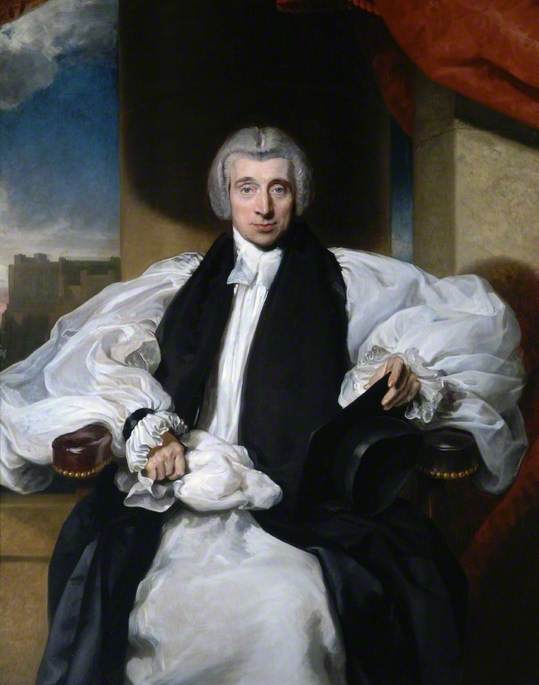
William Van Mildert, Prince Bishop of Durham 1826 – 1836. Portrait by Thomas Lawrence, courtesy of Auckland Castle
William Van Mildert, Prince Bishop of Durham 1826 – 1836. Portrait by Thomas Lawrence, courtesy of Auckland Castle
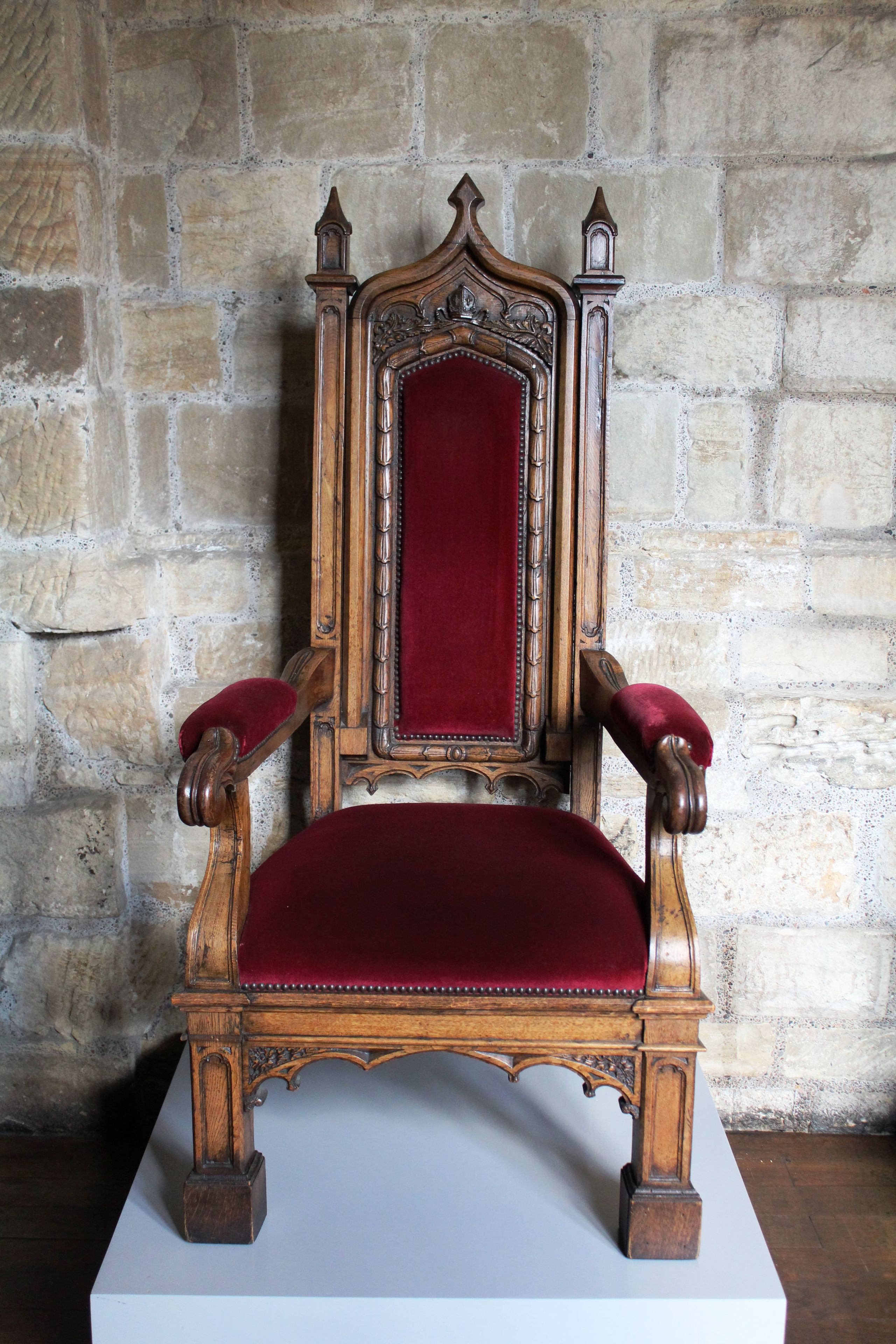
Bishop Van Mildert's throne at Durham Castle
Bishop Van Mildert's throne at Durham Castle
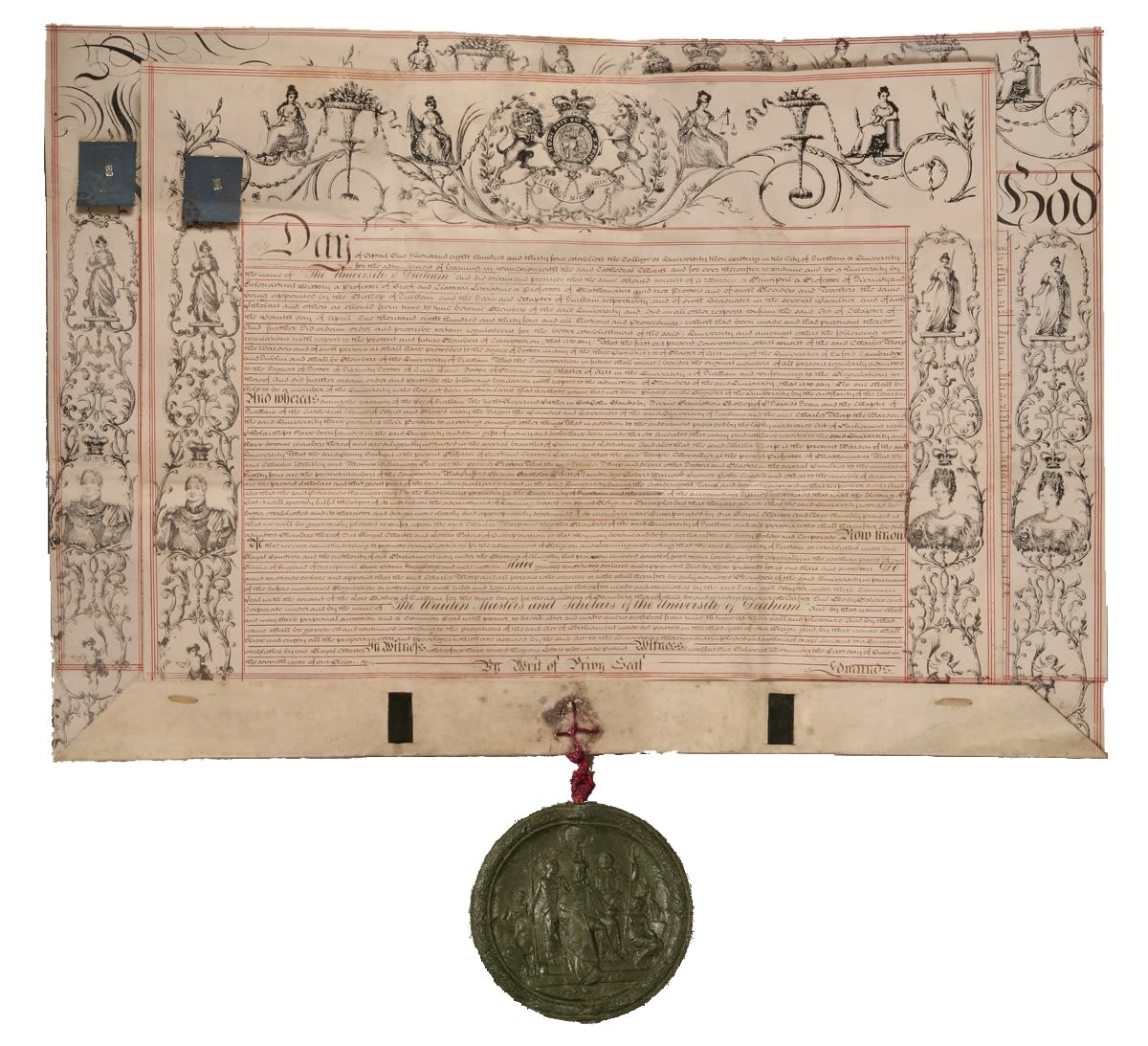
1837 royal charter confirming the right to grant degrees at Durham University. Durham University Library Special Collections, END.UND_AA1_1
1837 royal charter confirming the right to grant degrees at Durham University. Durham University Library Special Collections, END.UND_AA1_1
The Last Prince Bishop
The title of Prince Bishop continued throughout the 18th century and beyond, with Durham Castle as the ceremonial centre of power.
Some Bishops in this period chose to use nearby Auckland Castle as their main residence, keeping Durham Castle for events and entertaining.

William Van Mildert, Prince Bishop of Durham 1826 – 1836. Portrait by Thomas Lawrence, courtesy of Auckland Castle

Bishop Van Mildert's throne at Durham Castle
William Van Mildert was the last Prince Bishop of Durham, and had the honour of hosting one of the last great ceremonial events at Durham Castle. Van Mildert’s feast in October 1827, was held for the Duke of Wellington and 100 distinguished guests, including author Sir Walter Scott.
“In the memory of no-one present had so splendid an entertainment been seen in the castle of Durham.”
Durham Advertiser

Menu from Van Mildert's Great Feast
Menu from Van Mildert's Great Feast
Van Mildert’s greatest legacy was supporting an 1832 Act of Parliament, allowing the founding of a university in Durham, with the castle donated to house its students.

1837 royal charter confirming the right to grant degrees at Durham University. Durham University Library Special Collections, END.UND_AA1_1
The death of Van Mildert in 1836 saw the remaining powers of the Prince Bishops passed to the monarchy, ending a public debate over the power of the church and how it used its income.
Durham University

The idea of a university in Durham had been around for some time. Both Henry VIII in the 16th century and Oliver Cromwell in the 17th century proposed a university at Durham.
Both of these attempts failed, and it was not until the Act of 1832 that Durham University was established. The the first students were admitted in autumn 1833.
In 1837, Durham Castle was formally handed over to the University, becoming University College. In the 1840s, substantial work was carried out, especially on the derelict Keep, which was turned into student accommodation.
These first students were expected to keep to a strict moral policy for manners and conduct, with attendance at meals and college chapel services mandatory, and visiting local inns and pubs forbidden. All were expected to be back at college before the closing of the gates at night, and academic dress was expected at all times while in Durham, except when rowing on the river.

A student named Edward Bradley, better known by his pseudonym, Cuthbert Bede, created many pen and ink sketches showing life in the early days of University College. These images depict a room on the Norman Gallery.
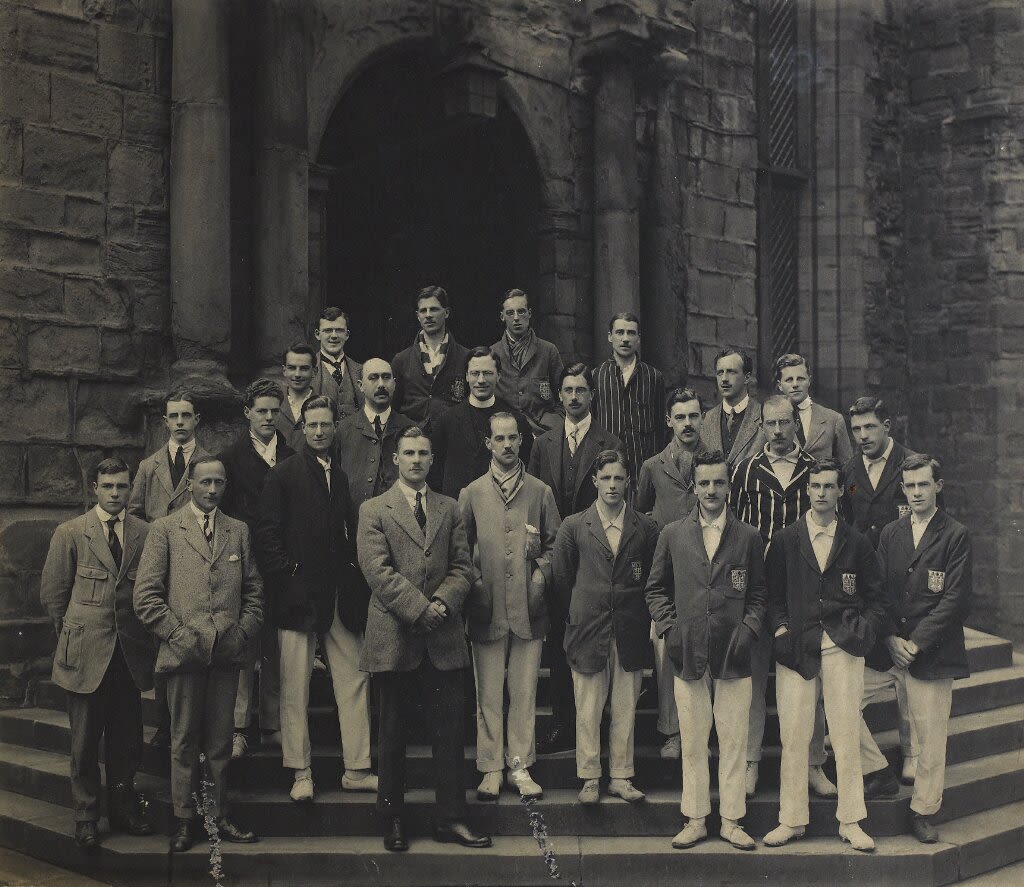
University College, 1919
University College, 1919
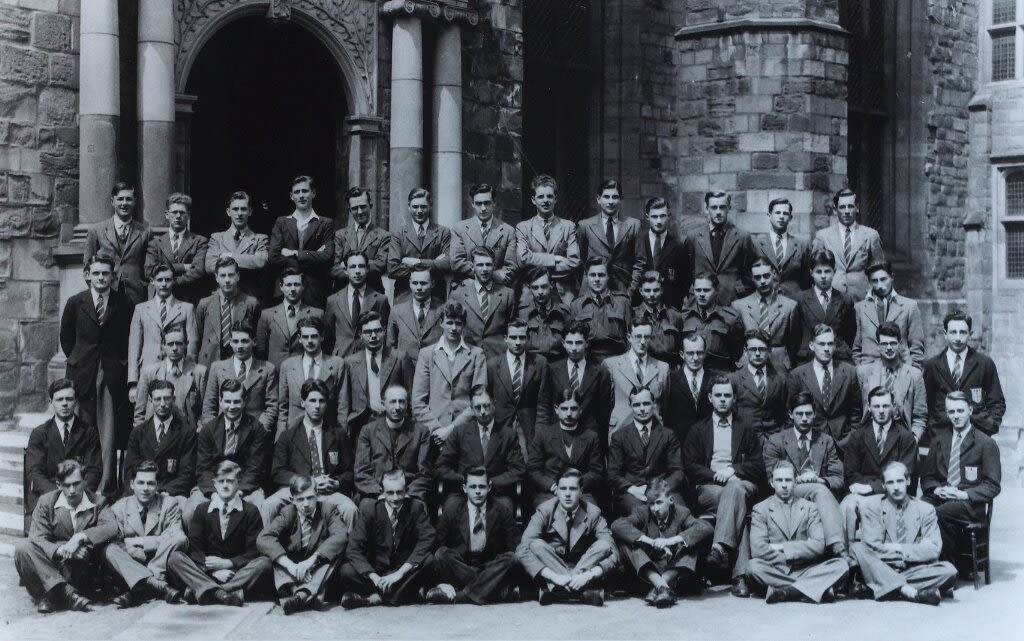
University College, 1944
University College, 1944
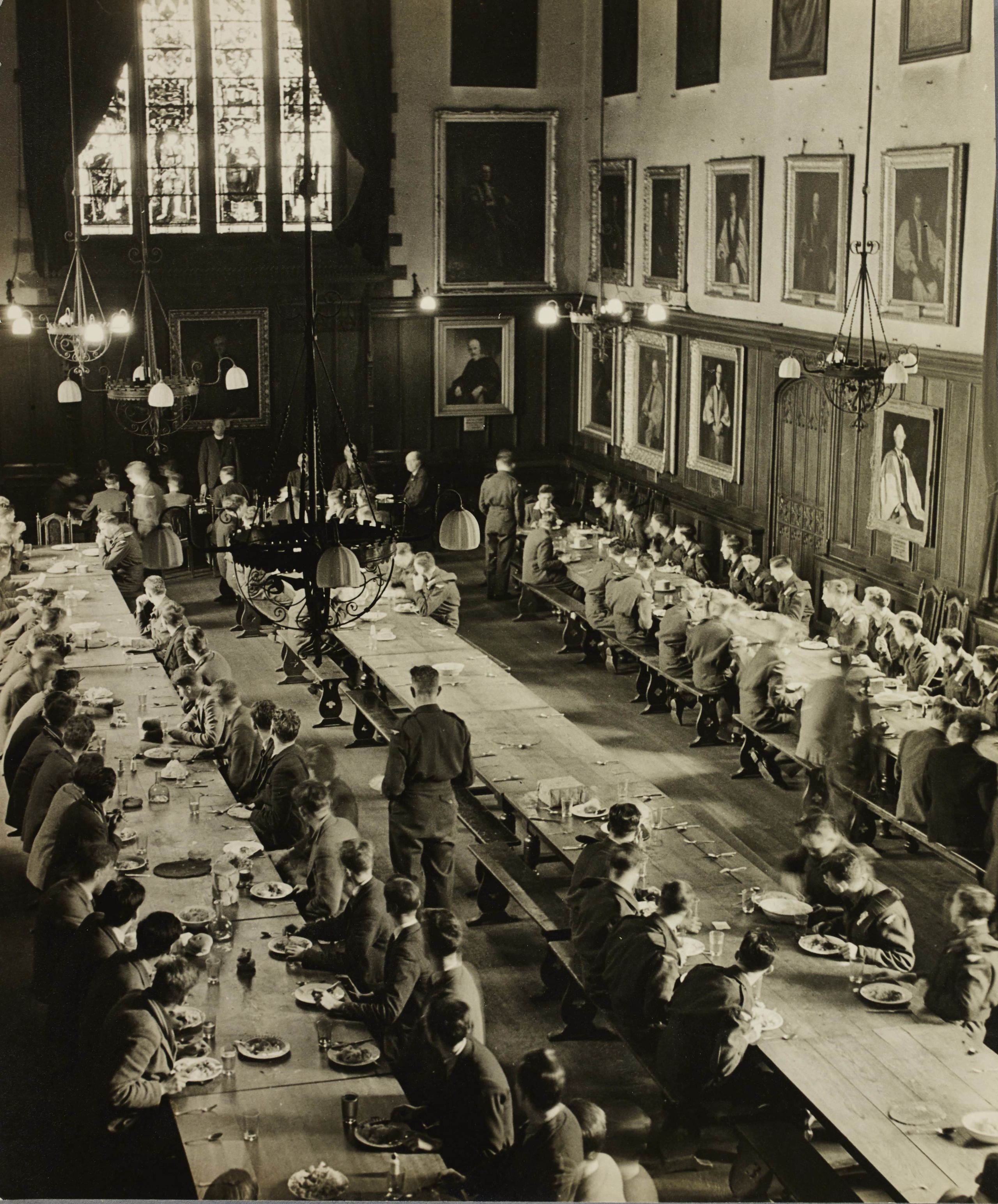
Durham University Air Squadron in the Great Hall
Durham University Air Squadron in the Great Hall
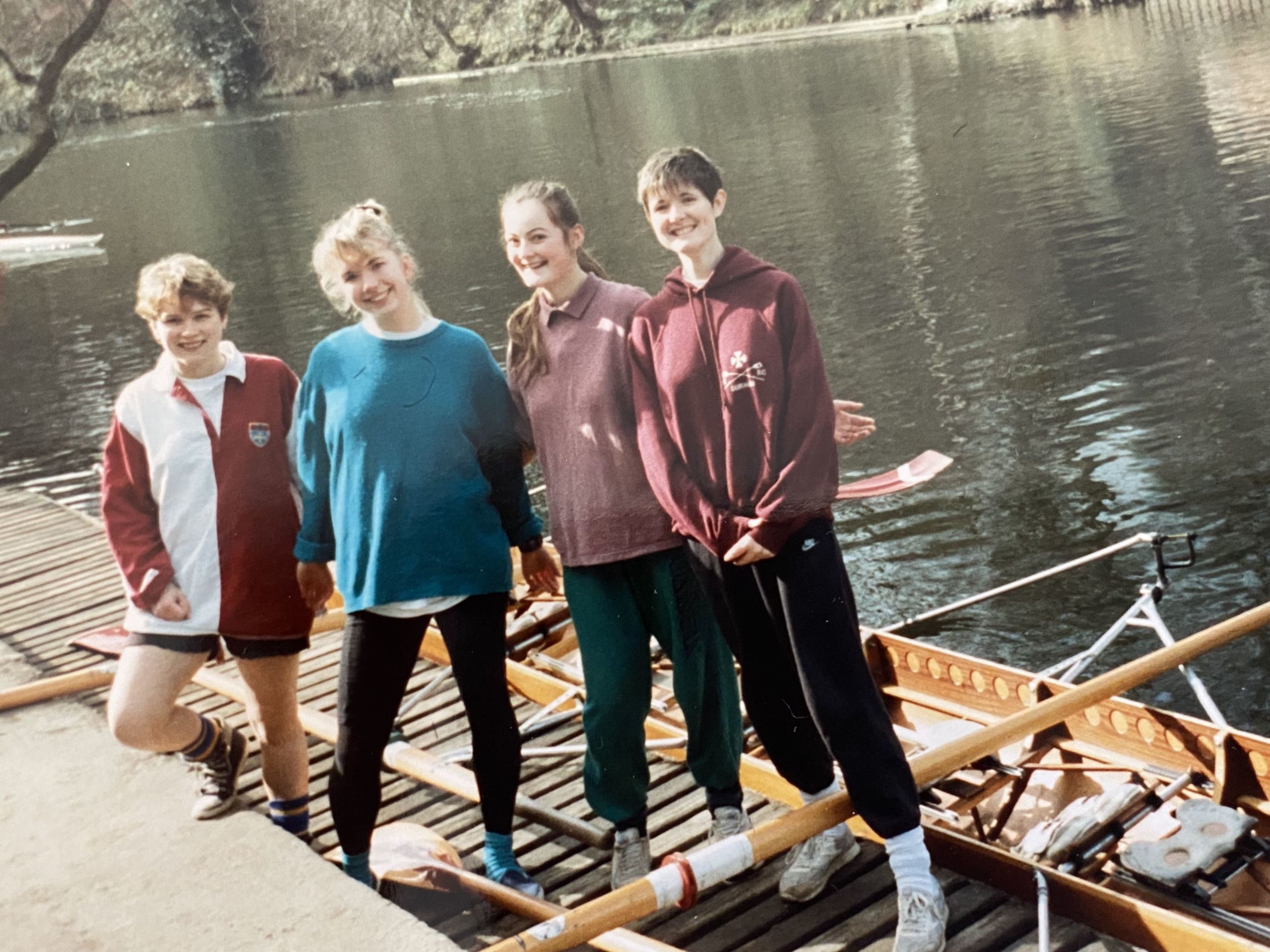
Some of the first women students at University College, c. 1990s
Some of the first women students at University College, c. 1990s
20th Century Castle
Moving into the 20th century, with Durham University now firmly established, rules for students began to relax, and University College became a central feature of the developing campus. The transformation into a vibrant student community was complete.

University College, 1919
The two World Wars had a significant effect on college life, with many staff and students enlisted to fight in World War I, and the castle used as a training site for officers of the Royal Air Force in World War II. Known as the Durham University Air Squadron, these trainee pilots and navigators undertook regular academic studies alongside their military training.

World War One soldiers from University College
World War One soldiers from University College
The organ in the Tunstall Chapel was restored and dedicated to those who died in the First World War, and the Norman Chapel was reconsecrated in 1951, to commemorate those members of the Royal Air Force who were at Durham, and who died during the Second World War.

University College, 1944

Durham University Air Squadron in the Great Hall
The second half of the 20th century saw the accommodation offered by University College expand beyond the walls of the castle, with newly built accommodation blocks on Palace Green.
The diversity of the student community continues to develop, and an early milestone was when women students were admitted to the college for the first time, in 1987.

Some of the first women students at University College, c. 1990s
This thriving community of staff and students has allowed Durham Castle to continue as a working castle and second home for many, who live and work in spaces that have been used for the past 1,000 years.

University College students working on a charity project to provide meals for homeless people
University College students working on a charity project to provide meals for homeless people
Durham Castle Today
Today, Durham Castle is home to the 1458 students of University College, including the 300 students who live in and around the Castle, and the Durham Peninsula.
It is not a historic castle frozen in time, it is a unique building. It combines within its walls stunning heritage, centuries of history and a vibrant living and working community.
Many of the spaces are still being used for their original purpose 1,000 years later, whether it is services in the two chapels, the kitchen making food, or the Great Hall serving meals.
It is also a popular venue and tourist attraction, with many private functions and bed and breakfast accommodation available during University holidays.
Due to the living nature of the castle, guided tours are the main way to explore Durham Castle. Most days, Durham Castle is open for tours, with visitors fascinated by the incredible history and its continuing function as a living, working and thriving building.
Follow us on social media for news about upcoming exhibitions and events.
Facebook Instagram Twitter



